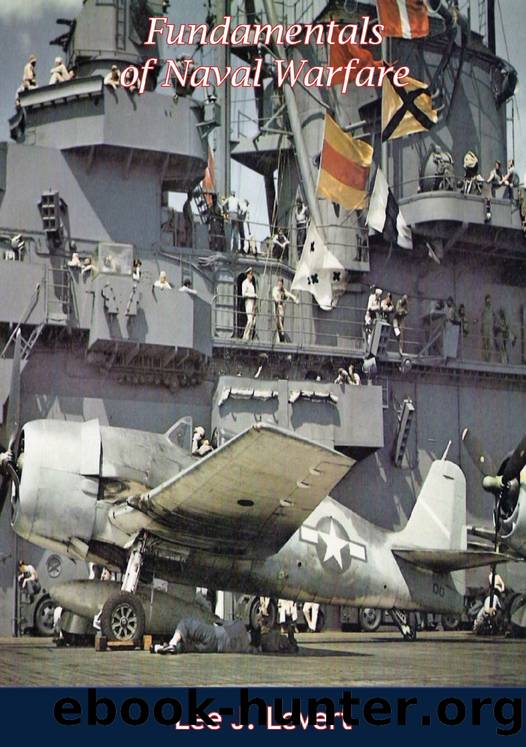Fundamentals of Naval Warfare by Lee J. Levert;William T. Brady;

Author:Lee J. Levert;William T. Brady;
Language: eng
Format: epub
Publisher: INscribe Digital
Published: 2019-07-18T00:00:00+00:00
CHAPTER 41âProtection
PROTECTIVE measures can all be classified as either active or passive. The aim of active defense is to prevent the occurrence of damage, while passive defense minimizes or limits the effect of damage actually inflicted by an enemy. It is often difficult to tell when a weapon on board a ship ceases to be offensive in nature and becomes defensive. In general, it may be said that the primary armament is offensive in character, while all other weapons exist merely to protect the carrier of this primary armament. There are exceptions, as when during an attack upon the Tirpitz by the British at Tromsö Fiord that ship opened up with her 15-inch guns at extreme elevation to break up the attack. Secondary batteries are primarily for defense, and yet even they have been used offensively in striking at convoys, for shore bombardment or against hostile light craft.
The primary weapons of an aircraft carrier are her bombers, and her active defense consists of fighter planes and guns. This is the current use of the aircraft carrier, but it appears that eventually these ships will not have offensive power of their own. They will merely supply cover for another type of offensive weapon, the land-based bomber. The guns of the aircraft carrier are not intended to be used as offensive weapons, since these ships are too valuable and too vulnerable to be risked in gun duels.
According to most texts, the primary weapon of the destroyer is the torpedo. That weapon is supposed to supply her reason for being. Yet tactical situations which arose in World War II made her 5-inch dual-purpose guns her main weapons of offense as well as of defense.
This interchangeability of functions does not apply to means of passive defense which, because of their nature, can never be used offensively. Means of passive defense can be classified as follows:
a.âProtective armor.
b.âWatertight bulkheads.
c.âBulges and outer skins.
d.âTorpedo nets.
e.âControl of damage effect.
Since it is simpler to determine what constitutes passive defense, that shall be analyzed first. Large warships, such as battleships, and to a far lesser extent cruisers, depend upon armor for the protection of their vitals. Any attempt to provide sufficient armor protection for the entire ship would entail a prohibitive armor weight. A given amount of weight is available for this purpose, and it must be concentrated at points where the protection is most vital. Otherwise it would be spread too thin and would prove ineffective against hits by heavy guns. Such vital parts as control stations, magazines, main batteries, and propulsion machinery must be well protected.
Although smaller warships have some armor protection, it is very limited, even as far as vital parts are concerned. A destroyer bears no armor at all except in her conning station, which contains the gun director, and in the forward portions of the gun houses. Even this protection assumes more the nature of splinter shields than of armor in the full sense of the term. A battleship is the only vessel to depend on armor for protection in addition to her watertight bulkheads and outer skins.
Download
This site does not store any files on its server. We only index and link to content provided by other sites. Please contact the content providers to delete copyright contents if any and email us, we'll remove relevant links or contents immediately.
The Radium Girls by Kate Moore(11570)
100 Deadly Skills by Clint Emerson(4650)
The Templars by Dan Jones(4538)
Rise and Kill First by Ronen Bergman(4530)
The Doomsday Machine by Daniel Ellsberg(4224)
The Rape of Nanking by Iris Chang(3994)
Killing England by Bill O'Reilly(3883)
Hitler in Los Angeles by Steven J. Ross(3780)
Stalin by Stephen Kotkin(3696)
12 Strong by Doug Stanton(3398)
Hitler's Monsters by Eric Kurlander(3134)
Blood and Sand by Alex Von Tunzelmann(3031)
Darkest Hour by Anthony McCarten(2998)
The Code Book by Simon Singh(2827)
The Art of War Visualized by Jessica Hagy(2814)
Hitler's Flying Saucers: A Guide to German Flying Discs of the Second World War by Stevens Henry(2610)
Babylon's Ark by Lawrence Anthony(2413)
The Second World Wars by Victor Davis Hanson(2409)
Tobruk by Peter Fitzsimons(2361)
